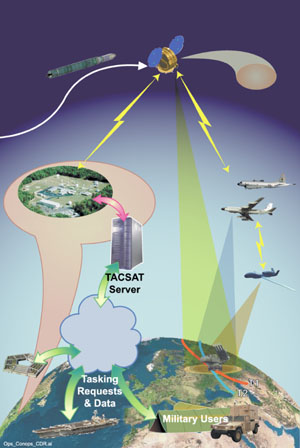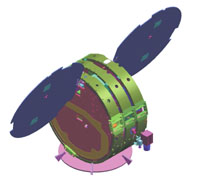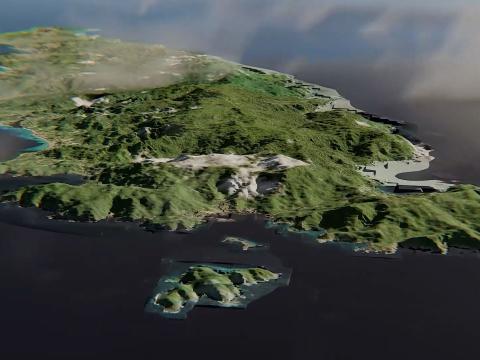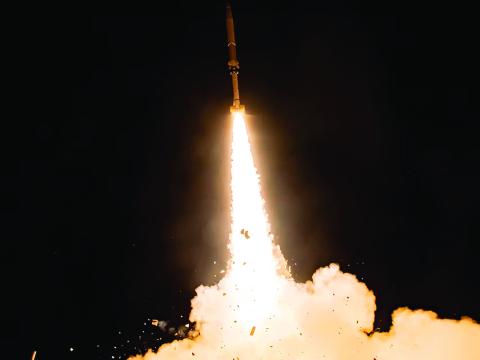Small Satellite Offers Glimpse of the Future
 |
TacSat-1 is designed to permit tactical air or ground users to control the satellite through the secret Internet protocol router network, or SIPRNET. |
A U.S. Navy and Air Force program is aiming to place an experimental surveillance platform in the high ground of space at bargain basement prices. If all goes according to plan, a 20-inch-high satellite will be orbited early this year for a series of experiments that could change the way battlefield forces receive surveillance, reconnaissance and situational awareness data.
The program combines existing military and commercial off-the-shelf technologies with a new commercial launch system providing more rapid and less expensive access to space. The experimental satellite, which is designed to last one year in orbit, will weigh only 240 pounds. Its design philosophy is to draw from traditional satellites and unmanned aerial vehicles (UAVs) in both function and hardware.
This effort is formally known as the Operationally Responsive Space Experiment. Its satellite is designated TacSat-1. The orbiter represents the first in a series of planned launches sponsored by the U.S. Defense Department’s Office of Force Transformation. The goal of the TacSat-1 effort is to design, build and launch a functioning experimental satellite into low earth orbit in less than one year for a total cost not exceeding $15 million. This initiative, which began last year, will culminate in a launch attempt this spring.
The Naval Research Laboratory is the program manager and is responsible for building the satellite. The Air Force Space Command’s Space and Missile Center is providing missile oversight for the commercial booster rocket, and its 30th Space Wing is providing the launch facility and launch services. The National Reconnaissance Office (NRO) is providing the payload processing facility.
TacSat-1 will explore three key capabilities: machine-to-machine collaboration between air and space assets for geolocation; tactical control of payload and dissemination of data through the secret Internet protocol router network, or SIPRNET; and specific emitter identification. The spacecraft will be equipped with two optical systems: an infrared camera that does not require cryogenic cooling and a visible-light digital camera.
Cdr. Gregory Glaros, USN, transformation strategist in the Office of the Secretary of Defense, characterizes TacSat-1 as a “concept/technology pairing experiment.” The goal is to observe how its concept evolves along with the technologies that came off the shelf.
Two of these technologies are key. One is the ability to have a space-based specific emitter identifier capability. The other is SIPRNET access across the wide user base.
The specific emitter identifier will produce “fingerprints from space,” Cdr. Glaros offers. “For the first time, we can cue and correlate information together in real time and provide the tactical user with global perspective.”
The SIPRNET capability allows users to control the actions of the satellite through the secure Internet network. A user would log onto a Web site to enter coordinates for the satellite to collect an image. This user would be determined by a simple algorithm that gates the requests according to established priorities.
Experts still are working out the mechanics of this SIPRNET control, Cdr. Glaros says. A groundstation at the Blossom Point Test Facility in Maryland that has the necessary throughput will handle the download. Still to be determined is whether the control happens automatically or manually. This is an important issue because it could take as long as seven days for the satellite to pass over the groundstation for downloads, Cdr. Glaros observes.
Another key feature is the horizontal integration and collaboration between an air and a space asset. In this case, an aircraft can cue TacSat-1 to look for and provide data with greater richness in geolocation. The space asset provides an assured capability to supply data for geolocation in a tiered manner among sea, ground and air assets, observes Lt. Col. Jay Raymond, USAF, transformation strategist in the Office of the Secretary of Defense. Each tier has its own niche, and these niches effectively are collected in this approach. Cdr. Glaros elaborates on that point.
“Space provides a unique perspective, and often that asset is fed into the larger system for analysis and dissemination throughout the wide body of defense,” the commander says. “What is different here is that space, now being cued by the aircraft coordinating the sparse aperture perspectives, gets real-time feedback from tactical users instead of from strategic implementers.”
 |
The TacSat-1 orbiter, slated for launch this spring, employs off-the-shelf technology to experiment with new capabilities for tactical forces. |
These off-the-shelf UAV parts include an ultrahigh frequency radio, Global Hawk instruments for the specific emitter identifier and the satellite’s power supply. Cdr. Glaros relates that the cameras were designed for atmospheric use, but they should work just as well in a space environment. Only a couple of TacSat-1’s components were developed in-house.
Researchers did need to change their plans for the visible-light camera. Original designs called for a focal-plane-array camera in which each pixel responds simultaneously to red, green and blue. However, that technology did not work well enough for TacSat-1. So, engineers instead incorporated a digital camera with a better electronic shutter, and this unit meets specifications.
The satellite bus is from Orbcomm via the NRO. It was left over from a constellation that had been launched. The bus itself is 41 inches in diameter and weighs 140 pounds. It can generate 88 watts of power and receive 186 watts more from its solar arrays.
TacSat-1 is designed to provide tactical operations security in that it would sense an enemy that would not know how it was being observed. While an adversary might know that a satellite is passing overhead, it would not necessarily know which sensing capability was being employed against it and in which frequencies it was being observed.
“Part of this whole endeavor is to have the autonomy that comes with microsatellites so that you don’t need a whole staff to operate and maintain it,” Cdr. Glaros says. “It certainly is autonomous—it comes on orbit, and it is accessible within a day or so.”
But it is the concepts of the TacSat effort that may produce the most significant changes. Cdr. Glaros states that the evolution of space access by the user base changes the methods and techniques that can be adopted by these users. TacSat-1 may spawn a cultural change that planners cannot predict. “We want the user base to have access to space as they would have access to fighters, access to close air support, access to artillery and access to information. And, we want them to utilize it in a way that we don’t know what they’ll do with it,” he suggests.
“When space is connected to the tactical or operational user, it changes the manner in which behavior occurs and in which organizations behave,” the commander posits. He cites the infrared and visual cameras as technologies that are not groundbreaking but that can significantly alter the capabilities of a wide user base. “The collective produces a knowledge base that has not been produced before. Often, the stovepipes cannot address or respond to these needs of the wider base.”
Throughout the timeline of the experiment, its defining factor has been its cost. The goal of developing a payload and orbiting the satellite for under $15 million is being attained, and a key to achieving it is a launch price of less than $6 million. TacSat-1 will be launched on the Falcon booster built by Space Exploration Technologies Corporation, known as SpaceX. The kerosene liquid-fuel rocket is capable of lofting a half-ton payload into low earth orbit, according to the El Segundo, California, company. The TacSat-1 launch will represent the company’s first customer, which is one reason why the cost will be considerably less than that of well-established launch companies and vehicles. The satellite’s spring launch is slated from Vandenberg Air Force Base, California, into a 500-kilometer (310-mile) orbit at 64 degrees inclination.
Work is underway on TacSat-2, and lessons already learned in the development of TacSat-1 have led to modifications in this successor vehicle. For example, the TacSat-1 specific emitter identifier uses 70 watts of power. In a few months, improved technology will enable that system to operate on only 7 watts. However, Cdr. Glaros relates that planners did not want to hold up TacSat-1 for several months to incorporate this advance. Instead, they will use most of that time to learn vital lessons from the spacecraft’s performance in orbit and its employment by users. So, the 7-watt technology will be incorporated into TacSat-2, which will use a bus originally developed for the Air Force’s TechSat program. TacSat-2 also will include better camera resolution.
Col. Raymond notes that, while the Navy Research Laboratory led the work on TacSat-1, its Air Force Research Laboratory partner primarily leads the work on TacSat-2. “We have already started seeing the synergies between the two laboratories,” he adds.
“It’s a type of spiral development in space,” the colonel continues. “It allows you to engage in time-capability tradeoffs to put something up without having to wait 15 years to get the next generation of capability.”
The different work on the two satellites will help answer many questions that must be addressed for the effort to proceed. Cdr. Glaros offers that these include determining the common interfaces that are needed to be responsive. These common interfaces could be at the bus level, the transmission control protocol/Internet protocol addressability level, the component level or the connection level, for example. So, TacSat-3 could feature a synergy of the TacSat-1 and TacSat-2 buses—or a totally different solution, depending on lessons learned from the two earlier missions.
Col. Raymond elaborates, “TacSat-2 will be a further iteration of some capabilities that were on TacSat-1, but who knows what will be on TacSat-3? TacSat-3 may represent a totally different capability.”




Comments